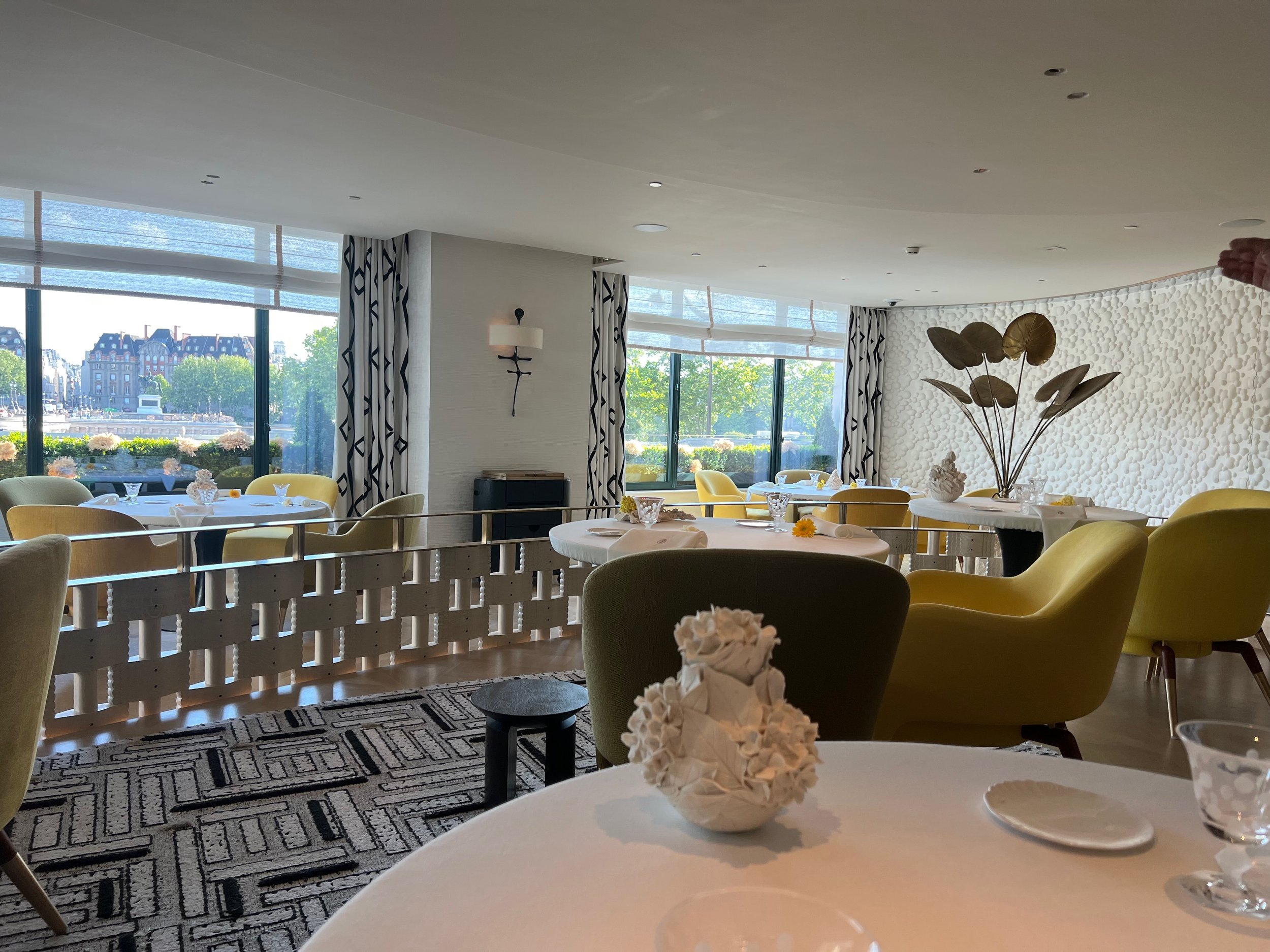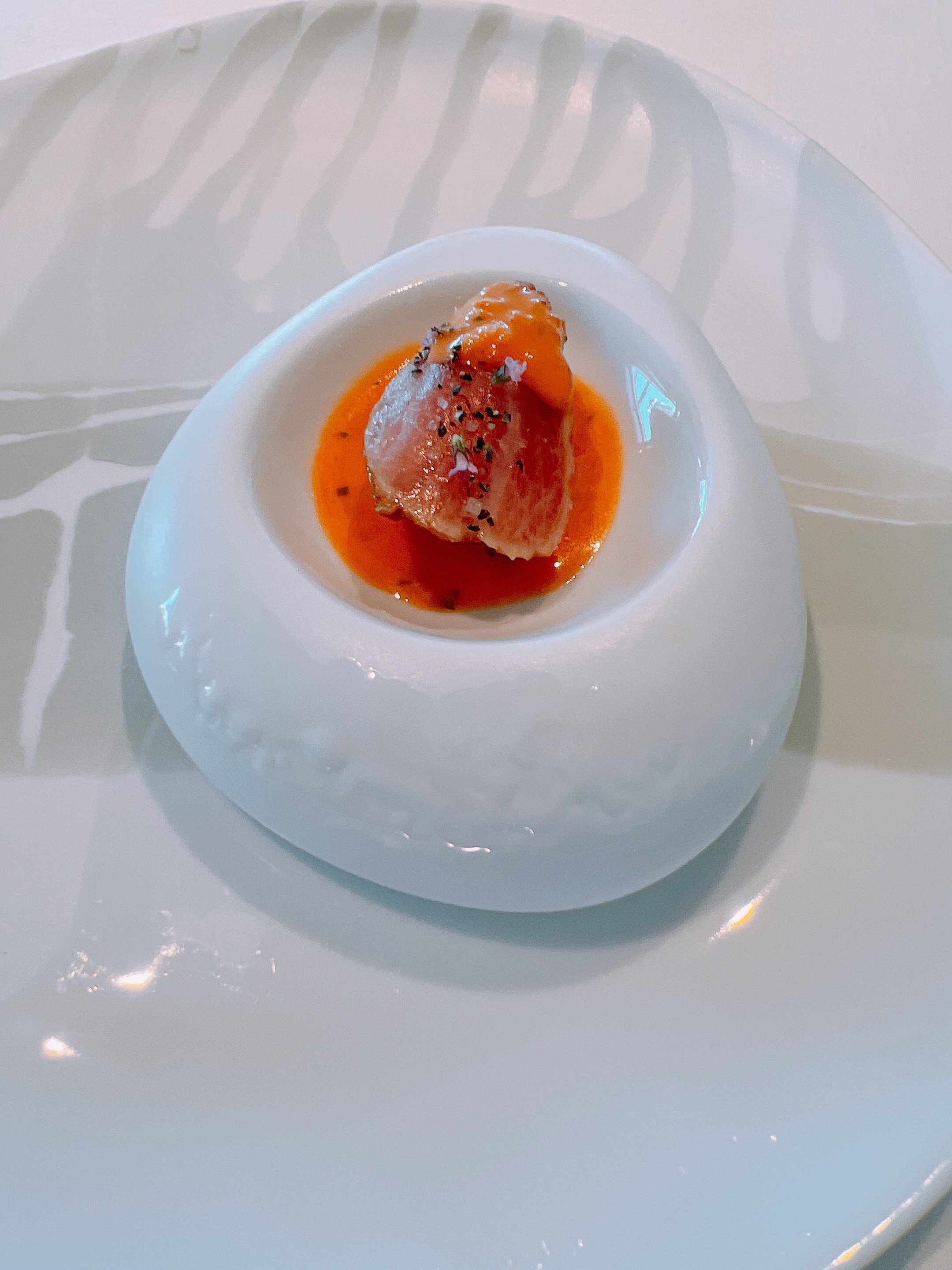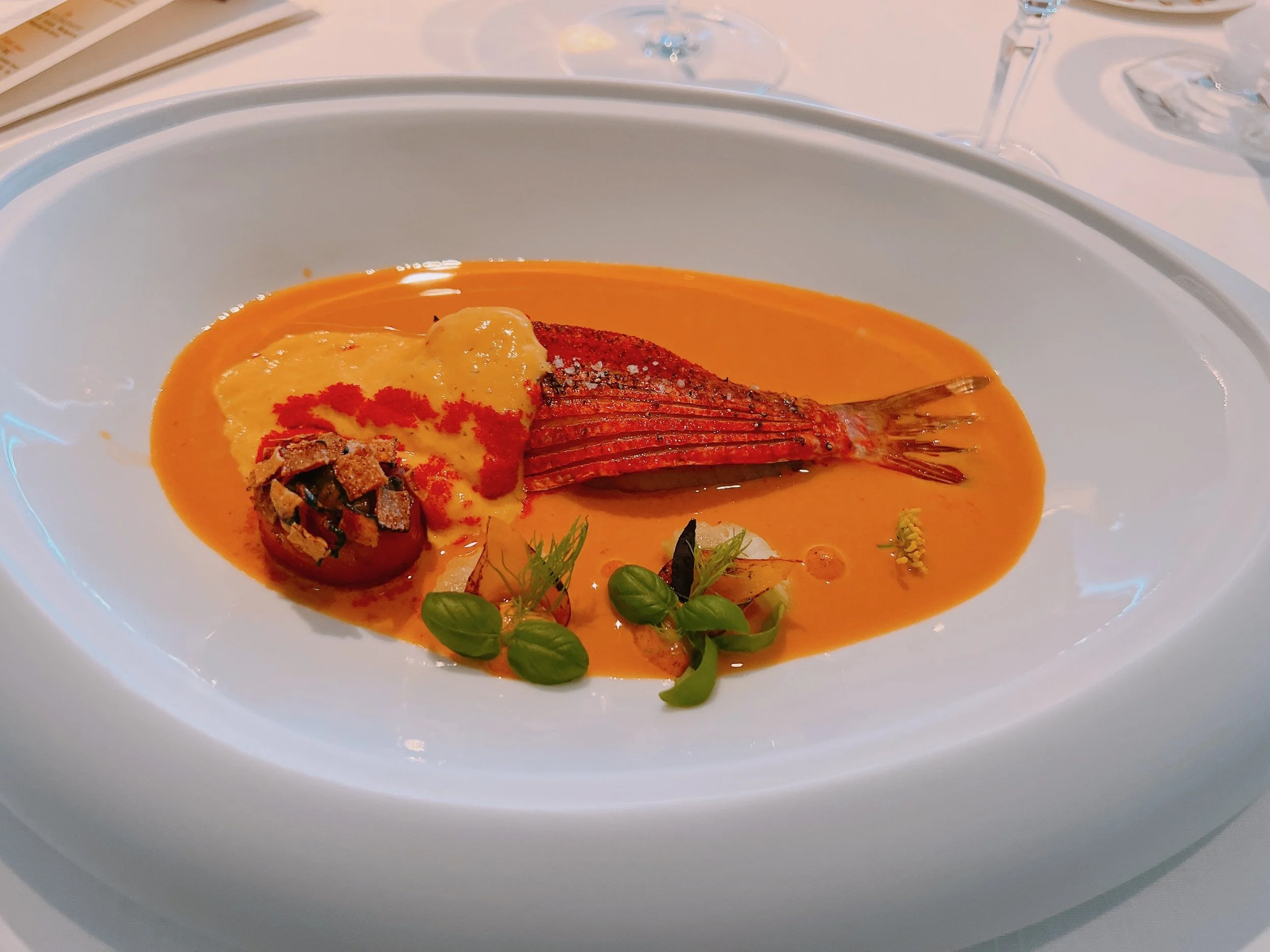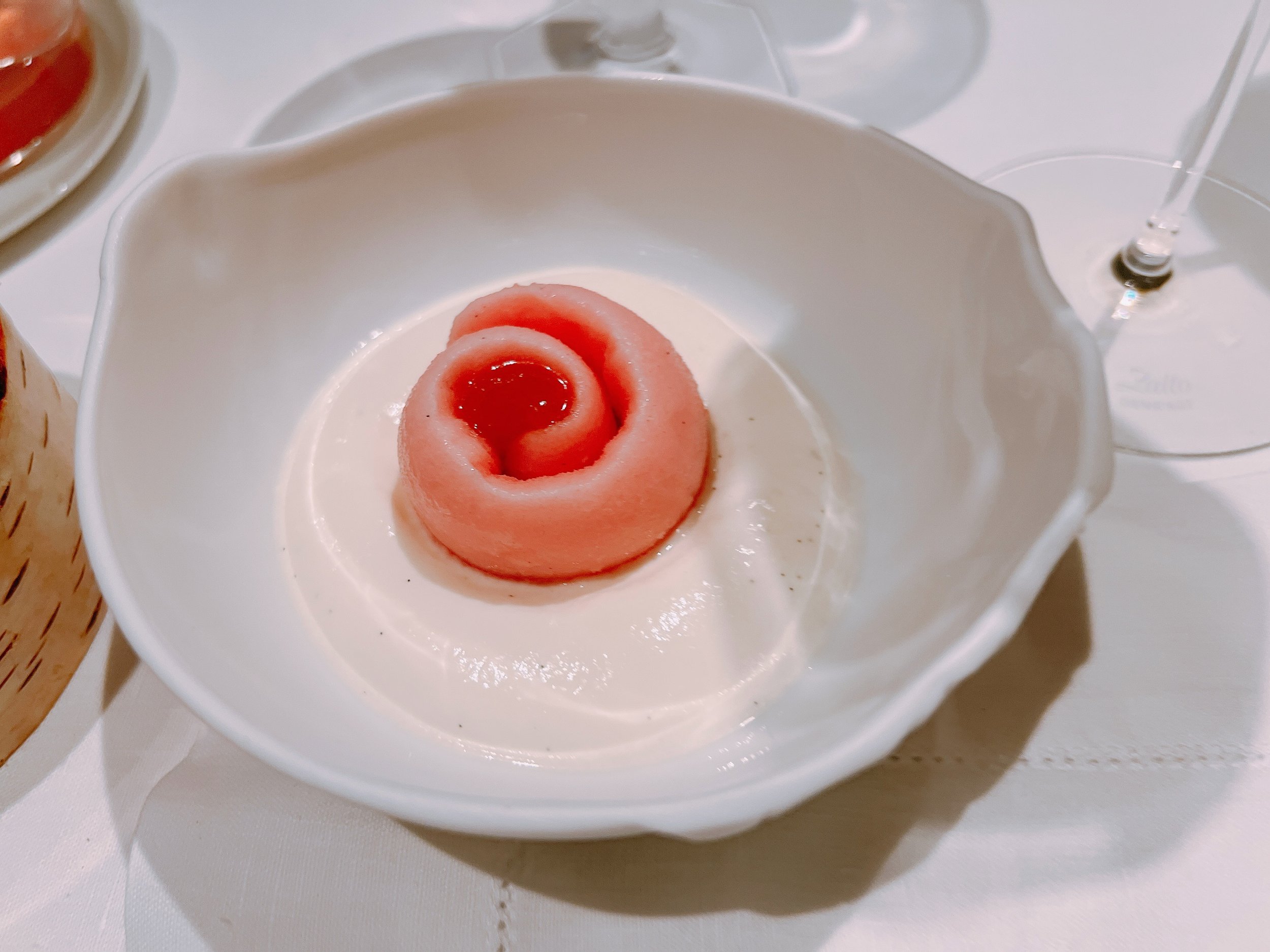Plénitude - Paris
Rating: 17/20
Where: Paris, France
When: Dinner for 2 on 9 July 2022
Cost per Person: Tasting menu 405 Euro, Wine pairing 195-480 Euro
Accolades: 3 Michelin Stars
Why: Mediterranean-inspired French cuisine with many unique sauces; beautiful view of the Seine
Plénitude is located in the brand-new Cheval Blanc hotel in Paris. Cheval Blanc is a mini luxury hotel chain owned by LVMH. There are only five hotels in the world in 2022, and the three that are in an area covered by the Michelin guide all have a three-starred restaurant. That probably sets some kind of record, or proves that with enough money in your back-pocket you can actually "create" Michelin three-star restaurants from thin air.
The Paris restaurant of the chain has the advantage of being the most accessible, and also being the only one that is open all year round. The named chef is the same as at the Cheval Blanc hotel in St Tropez, and there were indeed some similarities in cuisine, color scheme, decor and waitstaff dress. Yellow and white tones abound. Instead of the gorgeous view of the Gulf of St Tropez we had to "settle" for a 180-degree panorama of the Seine river - nothing to sneeze at either.
Before our dinner, we were given a tour of some display wine cases, containing the kind of wines that only a billionaire would order. Past the wine display, we saw a private dining room for up to seven guests. The main dining room had about ten tables, arranged on two levels so that everyone had a good view of the Seine. There was another table right next to the kitchen with a view of the (culinary) action, but this table was unfortunately not bookable - instead, every dining party got a turn to sit at this table and say hello to the kitchen crew for a palate cleanser course.
Which is as good a place as any to mention my main criticism of this restaurant. The speed with which the food was served was almost criminal. Barely had we finished a dish, that it would be taken away, the wine glass for the next pairing set down (with the previous one still more than half full), and the following dish arriving from the kitchen. In other words, there was barely any gap between courses. The first three (out of four total) savory dishes were served within about 30 minutes, so we were nearly done with our dinner after half an hour. Not only did we feel hurried and painfully stuffed, but it also seemed unnecessary since the restaurant doesn't flip any tables, and there were still guests arriving at the end of this 30 minute sprint. So what gives? I highly suspect it's the required visit to the kitchen table for every dining group. That requires that all tables are timed so that they don't hit that particular course at the same time. Easiest done by speeding up the early reservations and slowing down the later ones. Unfortunately, we happened to be in the former group.
All things considered I'd gladly have skipped the kitchen table if that had meant a more leisurely and less stressful dinner. Especially since for a kitchen visit this had the feeling of just checking a box: nothing was explained about different stations, nor were different chefs introduced. The only course served in the kitchen was essentially a cocktail, finished in about 30 seconds. Combined with the earlier tour of the wine cellar, I suspect that the restaurant wants to create a whole experience, not just a meal. But the result pales in comparison to a place like Frantzén, where the experience is much more elaborate and more prescribed, but so well executed that the result feels natural and unhurried.
After this rant, on to the food. The menu is a prix fixe with three savory courses and one sweet course to choose from a wide variety of dishes. An additional cheese course is optional. Alternatively, there is a tasting menu, which is simply one particular choice of the prix fixe dishes plus an additional savory course as well as the cheese course. We opted for the latter, but asked to receive two different desserts. There were two wine pairings at 195 and 480 Euro, respectively, and we tried the less expensive option. The pairing had generous pours (almost a regular glass of wine each) of generally nice wines but without any perfect food pairings.
The chef's running theme in the menu was “sauces”. Each dish was built around a particular sauce of the chef's invention. These sauces and their ingredients were listed prominently on the menu, and again in a small booklet that sat on our table during dinner. The sauces were often served in a glass to sip alongside the dish, and there was always plenty of extra sauce on the table to add to either the glass or the dish as desired. Given that sauces are often the best thing about French cuisine, that's an exciting idea.
Our first three bites were meant to evoke the sea. A slice of tuna atop raw vegetables was served with the first sauce, a vinaigrette based on grapefruit. The crunchy vegetables were very nice, but the tart vinaigrette overpowered the tuna 17. Smoked crab was served in its shell and topped with a sabayon. A beautiful dish: a great crab, a wonderful smokiness and a delicious sabayon. Close to perfect 19+. The third bite, a shrimp tartlet, was full of a jelly that made the shrimp seem a bit lost. Not terribly flavorful overall, though with a nice cracker, this was the weakest of the three starters 16.
A simple white bread was served warm with a decent butter. Good, but not at the level that we had at Le Pré Catelan the previous day, the butter felt undersalted 17. Later, we were served several flavored bread rolls (e.g. with nori, with sunflower seeds, with anchovy), every single one we tried was excellent 19.
Our next bite was meant to evoke a "walk in the garden", albeit a short one. A tartlet filled with tomatoes and topped with a pretty slice of zucchini was served next to a sauce based on celery. I wasn't a big fan of the pretty light sauce - it was an odd match with the very strongly flavored tartlet. The vegetables were very smoky - like a delicious BBQ. If all BBQs were like this, nobody would miss the meat 19 (the sauce by itself might have been a 15).
The last pair of amuse bouches followed. A grilled oyster was seasoned with fennel and served under a champagne foam. It's quite rare to see perfect grill marks on an oyster - they almost looked like they were painted on. The jelly covering the oyster overwhelmed the more subtle oyster flavor (similar to the shrimp earlier), and there was not much smokiness in evidence 17. A rye crisp was covered with caviar that had been (atypically) prepared like bottarga - dried, sliced, slightly chewy, salty and very intensely flavored. Truly unique, for novelty's sake alone this is a 19. Served in a glass next to these two dishes was a sauce of shellfish jus with lemon and fennel. The sauce could have been served warmer, but otherwise it exhibited a perfect, delicious seafood flavor 19.
Course one was a variation on the "market vegetable" dish. Several roasted and smoked vegetables such as artichokes, zucchini, onions and tomatoes were served with a gazpacho foam and the vinaigrette "Eugenie" - the latter named after the restaurant Pres d'Eugenie where the chef had previously worked. “Market” dishes like these live or die depending on the quality of the ingredients. This particular dish felt oddly light in flavor - both the vegetables and the vinaigrette were not that distinctive. Adding plenty of salt helped a little bit, but we had hoped for stronger flavors at the beginning of the menu. As a "bounty of the garden" menu in the middle of the summer (where good produce should be plentiful) it fell a bit flat 16.
Next came a sardine served with escabeche and tomatoes. The tomatoes in this dish tasted much better than in the previous course; there were several varieties of them and they all had their own taste profile. The sardine was a bit weaker - we would have liked a more pronounced taste, although I didn't try the add-salt-to-it trick this time 17.
Course number three was a turbot meuniere topped with caviar and served with shellfish, hazelnuts and a potato, all surrounded by a fish broth sauce containing oysters. The sauce was lovely in its seafoody richness, the fish excellent, the potato very good as well, but the shrimp just so-so, they were overwhelmed by the sauce 18.
After this, we finally took our quick trip to the kitchen. We were served a "trou normand": an apple sorbet and a cider granite, topped by some calvados. Nice and refreshing, but without any significant alcohol content 17.
Back at our table, the pace of the dinner finally slowed down a bit. The final savory course was veal, served with tomatoes, zucchini, chanterelles, and caramelized sweetbreads. In decreasing order of how much I liked the components: the tomatoes were nice, the veal ok, but unmemorable, the sweetbreads downright awful. Mealy and clayish in texture, they were unfortunately not my thing at all - a chore to finish 14.
Much better was the pescatarian replacement for the main course: red mullet with a bouillabaisse sabayon and potatoes. A lovely sauce bursting of seafood flavor (although maybe also a bit short on salt), a very nicely done fish, and a great potato with some (potato?) crumbles on top. Very good indeed 18.
The following cheese course was mostly very good; we opted for some excellent vanilla tomato jam to accompany our selection. A pleasant side salad and a whole new loaf of bread (in case we were still hungry?) completed the course.
We had ordered two different desserts, and each started with a prelude in the form of a matching fruit water. Raspberry verbena water preceded the "default" dessert of the tasting menu. This dessert was a meringue with verbena and raspberries on top of a biscuit. Artfully presented, it was a lovely dessert, although the raspberries dominated the taste making this ostensibly a single-note dish 17.
The other dessert was introduced by a rhubarb/vanilla flavored water. Not surprisingly, the dessert featured rhubarb and vanilla as well: curried rhubarb, a sabayon, a cracker, and jus of rhubarb. On the side was a rhubarb ice cream with vanilla foam. The classic rhubarb/vanilla combination worked really well, different textures, temperatures and levels of acidity creating nice contrasts that worked well together 18.
Final bites followed. One consisted of citrus fruit and ginger, topped with cream; heavy on grapefruit, this was an unexpectedly tart dish 17. A meringue filled with strawberry and orange was sweeter and a very nice combination 18. Finally, a marigold/olive oil ice cream was served with port wine, kirsch and some cherries. Nuts provided a bit of crunch, the cherries were very nice indeed, but the ice cream was overwhelmed by these other flavors 17.
Our parting gift was a pastry filled with rice pudding and raspberries. An excellent dough, but an unusual filling that I wouldn’t go out of my way to try again 18.
Overall: It's always unfortunate when the main takeaway from a dinner is not food-related but service-related: in this case the extreme hurry in which the meal was served. When I spend this much money on a dinner, I'm looking forward to a nice, relaxed meal and not a speed-eating competition. The Mediterranean French, seafood-heavy cuisine was good and varied, but unfortunately its perceived quality also varied wildly, all the way from zero to three Michelin stars. While I liked the ideas behind all of the dishes, and the overall focus on sauces, this unfortunately didn't result in an amazing meal. Given that the sister restaurant in St Tropez was way, way better on our visit there, these are hopefully only teething problems that will resolve themselves in time 17.



















